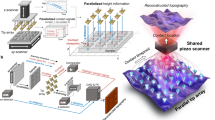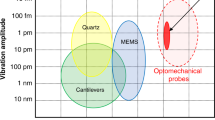Abstract
The success of high-speed atomic force microscopy in imaging molecular motors1, enzymes2 and microbes3 in liquid environments suggests that the technique could be of significant value in a variety of areas of nanotechnology. However, the majority of atomic force microscopy experiments are performed in air, and the tapping-mode detection speed of current high-speed cantilevers is an order of magnitude lower in air than in liquids. Traditional approaches to increasing the imaging rate of atomic force microscopy have involved reducing the size of the cantilever4,5, but further reductions in size will require a fundamental change in the detection method of the microscope6,7,8. Here, we show that high-speed imaging in air can instead be achieved by changing the cantilever material. We use cantilevers fabricated from polymers, which can mimic the high damping environment of liquids. With this approach, SU-8 polymer cantilevers are developed that have an imaging-in-air detection bandwidth that is 19 times faster than those of conventional cantilevers of similar size, resonance frequency and spring constant.
This is a preview of subscription content, access via your institution
Access options
Subscribe to this journal
Receive 12 print issues and online access
$259.00 per year
only $21.58 per issue
Buy this article
- Purchase on Springer Link
- Instant access to full article PDF
Prices may be subject to local taxes which are calculated during checkout




Similar content being viewed by others
References
Kodera, N., Yamamoto, D., Ishikawa, R. & Ando, T. Video imaging of walking myosin V by high-speed atomic force microscopy. Nature 468, 72–76 (2010).
Igarashi, K. et al. Traffic jams reduce hydrolytic efficiency of cellulase on cellulose surface. Science 333, 1279–1282 (2011).
Fantner, G. E., Barbero, R. J., Gray, D. S. & Belcher, A. M. Kinetics of antimicrobial peptide activity measured on individual bacterial cells using high-speed atomic force microscopy. Nature Nanotech. 5, 280–285 (2010).
Walters, D. A. et al. Short cantilevers for atomic force microscopy. Rev. Sci. Instrum. 67, 3583–3590 (1996).
Ando, T. et al. A high-speed atomic force microscope for studying biological macromolecules. Proc. Natl Acad. Sci. USA 98, 12468–12472 (2001).
Li, M., Tang, H. X. & Roukes, M. L. Ultra-sensitive NEMS-based cantilevers for sensing, scanned probe and very high-frequency applications. Nature Nanotech. 2, 114–120 (2007).
Antognozzi, M. et al. A new detection system for extremely small vertically mounted cantilevers. Nanotechnology 19, 384002 (2008).
Sanii, B. & Ashby, P. D. High sensitivity deflection detection of nanowires. Phys. Rev. Lett. 104, 147203 (2010).
Minne, S. C. et al. Centimeter scale atomic force microscope imaging and lithography. Appl. Phys. Lett. 73, 1742–1744 (1998).
Mertz, J., Marti, O. & Mlynek, J. Regulation of a microcantilever response by force feedback. Appl. Phys. Lett. 62, 2344–2346 (1993).
Sader, J. E. Frequency response of cantilever beams immersed in viscous fluids with applications to the atomic force microscope. J. Appl. Phys. 84, 64–76 (1998).
Milhiet, P.-E. et al. Deciphering the structure, growth and assembly of amyloid-like fibrils using high-speed atomic force microscopy. PLoS ONE 5, e13240 (2010).
Uchihashi, T., Iino, R., Ando, T. & Noji, H. High-speed atomic force microscopy reveals rotary catalysis of rotorless F1-ATPase. Science 333, 755–758 (2011).
Casuso, I. et al. Characterization of the motion of membrane proteins using high-speed atomic force microscopy. Nature Nanotech. 7, 525–529 (2012).
Preiner, J. et al. IgGs are made for walking on bacterial and viral surfaces. Nature Commun. 5, 4394 (2014).
Genolet, G. et al. Soft, entirely photoplastic probes for scanning force microscopy. Rev. Sci. Instrum. 70, 2398–2401 (1999).
Sulchek, T. et al. High-speed tapping mode imaging with active Q control for atomic force microscopy. Appl. Phys. Lett. 76, 1473 (2000).
Sulchek, T., Yaralioglu, G., Quate, C. & Minne, S. Characterization and optimization of scan speed for tapping-mode atomic force microscopy. Rev. Sci. Instrum. 73, 2928–2936 (2002).
Humphris, A. D. L., Miles, M. J. & Hobbs, J. K. A mechanical microscope: high-speed atomic force microscopy. Appl. Phys. Lett. 86, 034106 (2005).
Rosa-Zeiser, A., Weilandt, E., Hild, S. & Marti, O. The simultaneous measurement of elastic, electrostatic and adhesive properties by scanning force microscopy: pulsed-force mode operation. Meas. Sci. Technol. 8, 1333–1338 (1997).
Herruzo, E. T., Perrino, A. P. & Garcia, R. Fast nanomechanical spectroscopy of soft matter. Nature Commun. 5, 3126 (2014).
Smith, D. Limits of force microscopy. Rev. Sci. Instrum. 66, 3191–3195 (1995).
Gross, L., Mohn, F., Moll, N., Liljeroth, P. & Meyer, G. The chemical structure of a molecule resolved by atomic force microscopy. Science 325, 1110–1114 (2009).
Rugar, D., Budakian, R., Mamin, H. & Chui, B. Single spin detection by magnetic resonance force microscopy. Nature 430, 329–332 (2004).
Kindt, J. H., Fantner, G. E., Thompson, J. B. & Hansma, P. K. Automated wafer-scale fabrication of electron beam deposited tips for atomic force microscopes using pattern recognition. Nanotechnology 15, 1131–1134 (2004).
Martin, C. et al. Stress and aging minimization in photoplastic AFM probes. Microelectron. Eng. 86, 1226–1229 (2009).
Fantner, G. E. et al. Components for high speed atomic force microscopy. Ultramicroscopy 106, 881–887 (2006).
Schitter, G., Allgöwer, F. & Stemmer, A. A new control strategy for high-speed atomic force microscopy. Nanotechnology 15, 108–114 (2004).
Kodera, N., Sakashita, M. & Ando, T. Dynamic proportional-integral-differential controller for high-speed atomic force microscopy. Rev. Sci. Instrum. 77, 083704 (2006).
Calleja, M. et al. Highly sensitive polymer-based cantilever-sensors for DNA detection. Ultramicroscopy 105, 215–222 (2005).
Adams, J. D. et al. High-speed imaging upgrade for a standard sample scanning atomic force microscope using small cantilevers. Rev. Sci. Instrum. 85, 093702 (2014).
Burns, D. J., Youcef-Toumi, K. & Fantner, G. E. Indirect identification and compensation of lateral scanner resonances in atomic force microscopes. Nanotechnology 22, 315701 (2011).
Nievergelt, A. P., Erickson, B. W., Hosseini, N., Adams, J. D. & Fantner, G. E. Studying biological membranes with extended range high-speed atomic force microscopy. Sci. Rep. 5, 11987 (2015).
Acknowledgements
The authors thank C. Rashti, P. Odermatt and M. Dukic-Pjanic for their assistance. The authors thank the staff of the Centre of Micronanotechnology (CMi) at EPFL for microfabrication assistance and the Atelier de l'institut de production et robotique at EPFL for the fabrication of research equipment. This work was funded by the European Union's Seventh Framework Programme FP7/2007-2011 under grant agreement 286146 and the European Union's Seventh Framework Programme FP7/2007-2013/ERC grant agreement 307338, and the Swiss National Science Foundation through grants 205321_134786 and 205320_152675.
Author information
Authors and Affiliations
Contributions
J.D.A. designed experiments, built instrumentation, performed experiments, analysed data and wrote the paper. B.W.E. built instrumentation and performed experiments. J.G. performed experiments. J.B. designed experiments and coordinated research. A.N. built instrumentation and performed experiments. G.E.F. designed experiments, coordinated research and wrote the paper.
Corresponding author
Ethics declarations
Competing interests
The authors declare no competing financial interests.
Supplementary information
Supplementary information
Supplementary information (PDF 1215 kb)
Rights and permissions
About this article
Cite this article
Adams, J., Erickson, B., Grossenbacher, J. et al. Harnessing the damping properties of materials for high-speed atomic force microscopy. Nature Nanotech 11, 147–151 (2016). https://doi.org/10.1038/nnano.2015.254
Received:
Accepted:
Published:
Issue Date:
DOI: https://doi.org/10.1038/nnano.2015.254
This article is cited by
-
High-speed atomic force microscopy in ultra-precision surface machining and measurement: challenges, solutions and opportunities
Surface Science and Technology (2023)
-
SU-8 cantilever with integrated pyrolyzed glass-like carbon piezoresistor
Microsystems & Nanoengineering (2022)
-
Binary-state scanning probe microscopy for parallel imaging
Nature Communications (2022)
-
3D-printed cellular tips for tuning fork atomic force microscopy in shear mode
Nature Communications (2020)
-
A comprehensive model for transient behavior of tapping mode atomic force microscope
Nonlinear Dynamics (2019)



